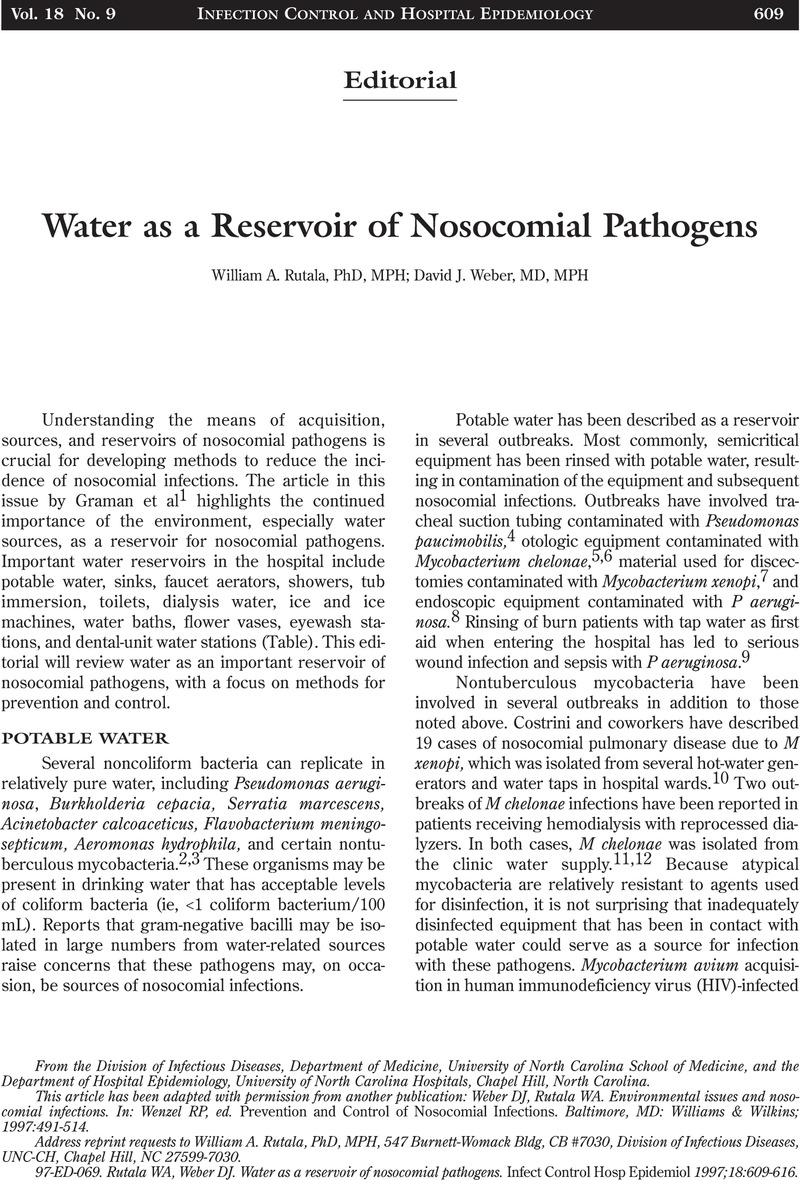Crossref Citations
This article has been cited by the following publications. This list is generated based on data provided by Crossref.
Kauppinen, Juha
Nousiainen, Tapio
Jantunen, Esa
Mattila, Rauni
and
Katila, Marja-Leena
1999.
Hospital Water Supply as a Source of Disseminated Mycobacterium fortuitum Infection in a Leukemia Patient.
Infection Control & Hospital Epidemiology,
Vol. 20,
Issue. 05,
p.
343.
Scola, Bernard
Barrassi, Lina
and
Raoult, Didier
2000.
Isolation of new fastidious α Proteobacteria and Afipia felis from hospital water supplies by direct plating and amoebal co-culture procedures.
FEMS Microbiology Ecology,
Vol. 34,
Issue. 2,
p.
129.
Penzak, Scott R.
Gubbins, Paul O.
Stratton, Shawna L.
and
Anaissie, Elias J.
2000.
Investigation of an Outbreak of Gram-Negative Bacteremia Among Hematology-Oncology Outpatients.
Infection Control & Hospital Epidemiology,
Vol. 21,
Issue. 9,
p.
597.
Hargreaves, James
Shireley, Larry
Hansen, Shannon
Bren, Virginia
Fillipi, Gordon
Lacher, Craig
Esslinger, Virginia
and
Watne, Terry
2001.
Bacterial Contamination Associated With Electronic Faucets: A New Risk for Healthcare Facilities.
Infection Control & Hospital Epidemiology,
Vol. 22,
Issue. 4,
p.
202.
Phillips, Michael S.
and
von Reyn, C. Fordham
2001.
Nosocomial Infections Due to Nontuberculous Mycobacteria.
Clinical Infectious Diseases,
Vol. 33,
Issue. 8,
p.
1363.
Holmes, Gary P.
Bond, Gregory B.
Fader, Robert C.
and
Fulcher, Samuel F.
2002.
A Cluster of Cases ofMycobacterium szulgaiKeratitis That Occurred after Laser‐Assisted In Situ Keratomileusis.
Clinical Infectious Diseases,
Vol. 34,
Issue. 8,
p.
1039.
Muscarella, Lawrence F.
2002.
Leading a Horse to Water: Are Crucial Lessons in Endoscopy and Outbreak Investigations Being Learned?.
Infection Control & Hospital Epidemiology,
Vol. 23,
Issue. 7,
p.
358.
Scola, Bernard La
Mezi, Liazyd
Auffray, Jean-Pierre
Berland, Yvon
and
Raoult, Didier
2002.
Patients in the Intensive Care Unit are Exposed to Amoeba-Associated Pathogens.
Infection Control & Hospital Epidemiology,
Vol. 23,
Issue. 8,
p.
462.
2003.
Recommended Practices for Cleaning and Processing Endoscopes and Endoscope Accessories.
AORN Journal,
Vol. 77,
Issue. 2,
p.
434.
Newport, Melanie
2003.
The genetics of nontuberculous mycobacterial infection.
Expert Reviews in Molecular Medicine,
Vol. 5,
Issue. 06,
Jarvis, William R.
2004.
The State of the Science of health care epidemiology, infection control, and patient safety, 2004.
American Journal of Infection Control,
Vol. 32,
Issue. 8,
p.
496.
Rutala, W.A
and
Weber, D.J
2004.
Reprocessing endoscopes: United States perspective.
Journal of Hospital Infection,
Vol. 56,
Issue. ,
p.
27.
Muscarella, Lawrence F
2004.
Infection control and its application to the administration of intravenous medications during gastrointestinal endoscopy.
American Journal of Infection Control,
Vol. 32,
Issue. 5,
p.
282.
Blanc, D. S.
Nahimana, I.
Petignat, C.
Wenger, A.
Bille, J.
and
Francioli, P.
2004.
Faucets as a reservoir of endemic Pseudomonas aeruginosa colonization/infections in intensive care units.
Intensive Care Medicine,
Vol. 30,
Issue. 10,
p.
1964.
Nelson, Douglas B.
Jarvis, William R.
Rutala, William A.
Foxx-Orenstein, Amy E.
Isenberg, Gerald
Dash, Georgia P.
Alvarado, Carla J.
Ball, Marilee
Griffin-Sobel, Joyce
Petersen, Carol
Ball, Kay A.
Henderson, Jerry
and
Stricof, Rachel L.
2004.
Multi-society Guideline for Reprocessing Flexible Gastrointestinal Endoscopes.
Diseases of the Colon & Rectum,
Vol. 47,
Issue. 4,
p.
413.
Rutala, W. A.
and
Weber, D. J.
2004.
Disinfection and Sterilization in Health Care Facilities: What Clinicians Need to Know.
Clinical Infectious Diseases,
Vol. 39,
Issue. 5,
p.
702.
Vaerewijck, Mario J.M.
Huys, Geert
Palomino, Juan Carlos
Swings, Jean
and
Portaels, Françoise
2005.
Mycobacteria in drinking water distribution systems: ecology and significance for human health.
FEMS Microbiology Reviews,
Vol. 29,
Issue. 5,
p.
911.
Brown, Linda Morris
Osato, Michael
You, Wei-cheng
El-Zimaity, Hala
Li, Ji-you
Zhang, Lian
and
Gail, Mitchell H.
2005.
Disinfection of endoscopes from Helicobacter pylori–positive subjects: Evaluation of the effectiveness of the Chinese Calijing disinfection kit.
American Journal of Infection Control,
Vol. 33,
Issue. 4,
p.
197.
2005.
Recommended Practices for High‐level Disinfection.
AORN Journal,
Vol. 81,
Issue. 2,
p.
402.
Horcajada, Juan P.
Martinez, Jose Antonio
Alcón, Amalia
Marco, Francesc
Lazzari, Elisa De
Matos, Anastacio de
Zaragoza, Magda
Sallés, Montse
Zavala, Elisabeth
and
Mensa, Josep
2006.
Acquisition of Multidrug-ResistantSerratia marcescensby Critically Ill Patients Who Consumed Tap Water During Receipt of Oral Medication.
Infection Control & Hospital Epidemiology,
Vol. 27,
Issue. 7,
p.
774.





